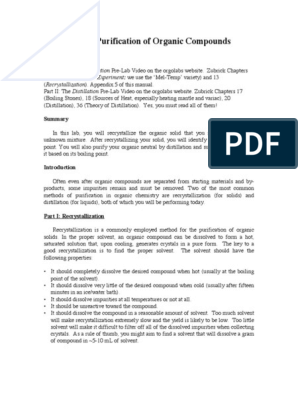0% found this document useful (0 votes)
48 views7 pagesExperiment 2 Lab Report Draft
The document discusses recrystallization as a technique for purifying solid compounds. It involves dissolving the compound in a suitable solvent, allowing crystals to form from the solution which excludes impurities, and isolating the purified crystals. The document outlines the steps of recrystallization including identifying a suitable solvent, dissolving and filtering an impure sample, cooling the solution to induce crystal formation, and verifying purity through melting point comparison.
Uploaded by
Alexandria Nicole CaalimCopyright
© © All Rights Reserved
We take content rights seriously. If you suspect this is your content, claim it here.
Available Formats
Download as DOCX, PDF, TXT or read online on Scribd
0% found this document useful (0 votes)
48 views7 pagesExperiment 2 Lab Report Draft
The document discusses recrystallization as a technique for purifying solid compounds. It involves dissolving the compound in a suitable solvent, allowing crystals to form from the solution which excludes impurities, and isolating the purified crystals. The document outlines the steps of recrystallization including identifying a suitable solvent, dissolving and filtering an impure sample, cooling the solution to induce crystal formation, and verifying purity through melting point comparison.
Uploaded by
Alexandria Nicole CaalimCopyright
© © All Rights Reserved
We take content rights seriously. If you suspect this is your content, claim it here.
Available Formats
Download as DOCX, PDF, TXT or read online on Scribd
/ 7

































































